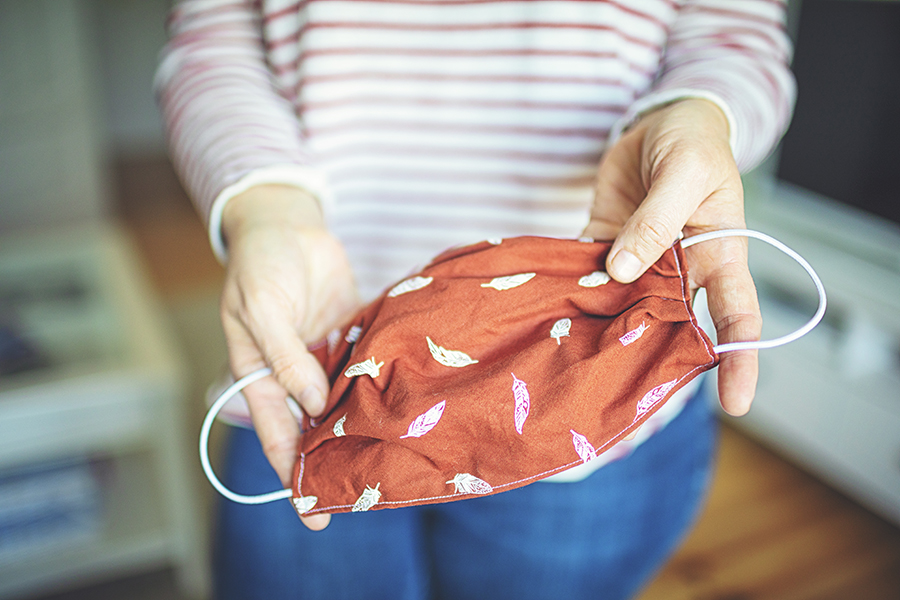What You Need to Know about Wearing a Face Mask during the COVID-19 Crisis
Including how to make your own and more regarding the latest face mask recommendations from the CDC.

Photo via Getty Images
On May 1 Governor Charlie Baker issued a face-covering mandate where social distancing is not possible, effective May 6. Businesses may decline entry to an individual refusing to wear a face mask and violation of the mask can result in a $300 fine. Full details can be found here.
Over the weekend, along with some new curfew guidelines suggested by Marty Walsh, Bostonians were encouraged to wear a face mask of some sort whenever they leave their home, even if they didn’t have reason to think they were sick. The previous recommendations for who should wear a mask had been under review by the Centers for Disease Control and Prevention, and by April 3 the guidelines were changed to recommend that everyone except infants should now be wearing one.
Originally, the hesitation to encourage more widespread mask usage came from the shortage of protective equipment for hospital workers and the concept that non-medical workers might buy up the supply. There were also concerns it would encourage more risky behavior, since wearing a mask might make people think they were safe. But the benefits outweigh these hypotheticals. George Gao, director general of the Chinese Center for Disease Control and Prevention, told the Washington Post, “Many people have asymptomatic or presymptomatic infections. If they are wearing face masks, it can prevent droplets that carry the virus from escaping and infecting others.”
It’s also a good visual reminder for people to not to touch their face and to keep their distance from people. As Jeremy Howard, a research scientist at the University of San Francisco who specializes in medical data analytics, told the Boston Globe, “Suggesting people not wear masks is like suggesting people shouldn’t have worn condoms at the height of the HIV crisis. It’s basically encouraging people to engage in harmful behavior.”
I am asking EVERYONE to wear a face covering whenever you leave your home.
This can be a scarf, bandanna, or other type of cloth. Up to 25% of people do not show symptoms & do not know they have the virus. By wearing face coverings in public we will slow the spread of #COVID19. pic.twitter.com/EOIMgETN5B
— Mayor Marty Walsh (@marty_walsh) April 6, 2020
The next two weeks in Boston, when we’re expected to see a peak of new cases hit hospitals, are critical. Along with continuing to follow strict social distancing standards, it’s time to also make sure your face is covered with some type of cloth face covering. Save the medical-grade N95 masks for medical workers, though. And remember: Even government officials like Walsh and Gov. Charlie Baker are donning face masks. It’s time you do the same. And to help you get started, here’s what you need to know about wearing, making, and buying a face mask to protect yourself, and others, from the coronavirus.
What are the new guidelines?
The CDC now recommends that everyone, with the exception of children under the age of two and anyone who has trouble breathing, “wear cloth face coverings in public settings where other social distancing measures are difficult to maintain.” This includes locations like the grocery store and pharmacy as well as areas of “significant community-based transmission.”
The cloth face coverings should not be surgical masks or N95 respirators—those should be reserved for medical workers. Any type of homemade covering works in a pinch, so don’t worry if what you come up with isn’t too fancy. According to the CDC, it simply needs to:
- fit snugly but comfortably against the side of the face
- be secured with ties or ear loops
- include multiple layers of fabric
- allow for breathing without restriction
- be able to be laundered and machine dried without damage or change to shape
Why do I need to wear one?
It’s been said throughout this pandemic that if you feel like you’re overreacting, that’s probably a good thing. The next two weeks in Boston, we’re expected to see a surge of newly confirmed cases of the virus. Ensuring everyone wears masks in public places prevents those carrying the virus who may not be showing any symptoms from passing it along to others.
Do I have to continue social distancing if I’m wearing a mask?
Absolutely. There’s really no ifs, ands, or buts about this one. Sorry, but a mask does not turn you into an invincible superhero, no matter how “cool” you make it look. Continue behaving as if you weren’t wearing one.

Photo via Getty Images
Can I use materials around my house to make one? And do I need a sewing machine?
Anything is better than nothing—to some extent. In a 2013 study, household materials were tested to see how well they blocked bacteria and viral aerosols. Although they didn’t block particles as well as surgical masks, the items used in the study were still better than nothing and could keep people from spreading the virus. The CDC is advising that “cloth face coverings fashioned from household items or made at home from common materials at low cost can be used as an additional, voluntary public health measure.” There are plenty of tutorials around the internet on how to craft your own DIY mask using things like t-shirts, bandanas, hair ties, sheets, and coffee filters without having the skills of a master tailor. As long as it fits snugly to your face and consists of at least two layers of fabric, you’re in business.
If I’m feeling extra crafty, how can I sew one?
If you’re the arts and crafts type who may have a sewing machine in the home, you can bust it out and get to work on a completely DIY face mask. All you need are two rectangular pieces of cotton fabric, two pieces of elastic (or rubber bands, hair ties, etc.), scissors, needle and thread, and a sewing machine. Full instructions are on the CDC’s website.
Where can I buy one?
Places like Home Depot, Ace, and Lowe’s have protective equipment still for sale as well as select CVS stores and other pharmacies, although those places might be on short supply. Amazon still has some face masks in stock as well. There are also some people and stores around Boston, like Vivant Vintage (which will be made available on their website soon), making homemade masks and asking for donations to their businesses that are currently closed due to COVID-19. Fall River bed linen company, Matouk has turned their factory into a mask making production, a Northeastern senior has started a Facebook forum to deliver mask-making kits to people around Boston, and a biology teacher has even put his 3D printer to work making masks. As mentioned earlier, when buying a mask, you should make sure it has two layers of fabric and will fit securely on your face.
Each of my 4 printers can make 4 masks every day. So 16 of these bad Larry’s every day to responders, or anyone who wants/needs one. pic.twitter.com/OdQod7hUFr
— Bennett Ahearn (@ahearnbNAHS) March 23, 2020
How should I wash my face mask, and how often?
The CDC says the washing machine should suffice for proper washing. As for how often you should wash it? That depends on how often you wear it. The CDC does not have recommendations for exactly how often you should wash it. Dr. William Schaffner, medical director of the National Foundation for Infectious Diseases in Bethesda, Maryland, told TODAY that while there are no recommendations on how often you should wash your face mask, once a week should suffice. “You shouldn’t be using them all that frequently anyways. You’re only going out to the pharmacy and supermarket,” he says.
Can I make and donate masks to hospital workers?
Yes. Nationally, JoAnn Fabrics is working to initiate a donation fund for masks that were created by the public, and they have instructions on their site so you can help them reach their goal of making 100,000,000 masks. If you have unopened hospital-grade masks, you can donate them as well as funds to local hospitals like Brigham and Women’s Hospital, Mass General, MIT, and Cambridge Health Alliance through online donation forms. The forms include details about what types of masks qualify, as well as lists of other types of donated items that hospitals are seeking. They may also take homemade masks (as CHA confirmed on Twitter), but make sure to read the fine print about whether they’ll take the type of mask you have before sending.
Should I wear a mask while running or exercising outside?
There are varying recommendations for this one. The Boston Public Health Commission recommends that everyone wear a face covering while outside, but the CDC has not specified if it’s necessary or not. Joseph Allen, an assistant professor of exposure and assessment science at Harvard University’s T.H. Chan School of Public Health, told the Globe that if you’re going outside for a run or a hike, you don’t need to wear one unless you’re in a place where you’re unable to maintain proper social distancing. But as more and more people gather outdoors as the weather improves, it’s wise to always ensure you bring some type of face covering when you leave the house. Another important aspect of your own mask practices is helping to change the culture around wearing masks to normalize it, and to serve as a visual reminder of the serious threat we’re living through right now.


